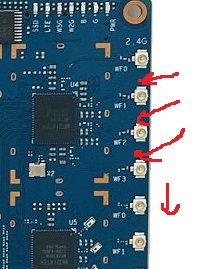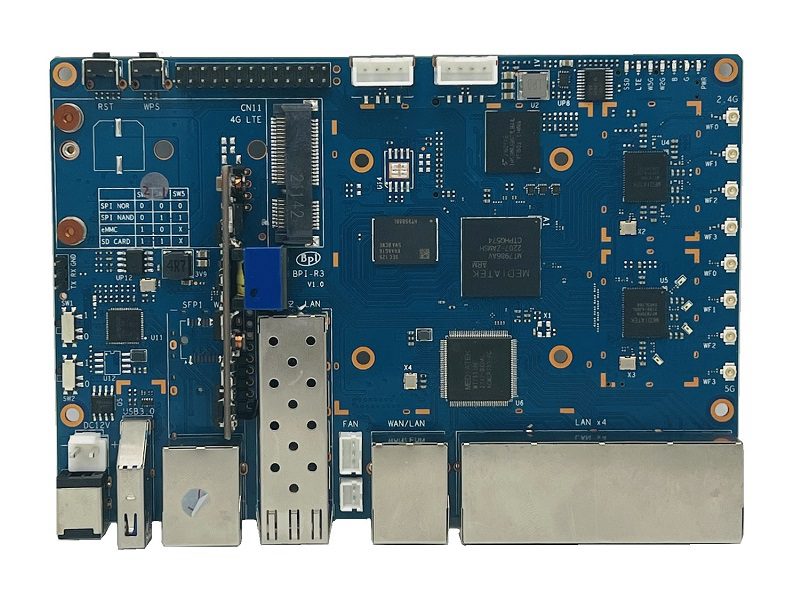Next to that, OpenWRT by default installs with radio’s set to disabled. So, don’t even have to worry about it at boot.
Hi,
If there is another PCB design in the pipes. Please consider adding more vias around the IPX connectors. It is a mechanically influenced area under a stress. The upper layer glue holding the copper layer is not enough.
I had to replace one IPX connector as it disintegrated already. It is a development platform, thus it should be designed with some sort of durability in mind.

Thanks.
Can BPI-R3 work with mPCI 4g modem and SSD drive at the same time? Or is it like “choose nand or emmc, but not both at the same time”?
How can I make 4g connection as backup connection? I want to use 4g if my main WAN connection die. Automatic connection switch ofc.
Do I need external 4g antenna? My 4g phone has -98 dbm signal.
Which SIM format BPI-R3 supports? Nano-SIM?
Mpcie slot has only usb2 connected,but many 4g modems only use these and do not need pcie lanes.
Emmc and nand are different controllers (mmc vs. Spi), so they can be used together. But not “emmc and sd” and/or “nand and nor”
Afaik automatic connection is possible if you trigger it via ifdown-script or similar. Sim slot is larger than nanosim and smaller than normal sim…afaik minisim
It depends how your case blocks signal (metal case will need external). Without case i used a flat antenna which i will try inside the printed case (if i can finally print it)
Any recommendation regarding a case for the board? How do you use it?
Currently i use the paperbox  there is an official metal case,but you need to add some ventilation holes. Or print a case like this:
there is an official metal case,but you need to add some ventilation holes. Or print a case like this:
I am currently printing a case at a local 3D printing service. We have recreated the plans from scratch and I intend to make them available free of charge since many of you, like you @frank-w, helped me a lot.
The 3D Printing Service, the owners name is Simon, is a really nice young entrepeneur which I can highly recommend. Once I got the case printed I will upload some images and the plans.
I am curious how power over ethernet support is achieved. In the wiki and sales listings I see ‘POE support (optional)’, how does PoE support work? However if I try to search for PoE support for this board I cannot find anything.
I don’t think it was ever really released (all the production boards I know of had two SFPs). There is however an image showing it here https://wiki.banana-pi.org/File:Banana_Pi_BPI-R3_with_PoE.jpg
Where you can see that it has swapped out the SFP with an RJ45, and then the PoE module installed there. I think based on the number of pins on the PoE in the photo it would be something like this module (I haven’t confirmed the pinouts myself though): https://kksb-cases.com/products/bpi-7402-poe-module
I saw the R3 PoE version on Amazon
That modules seems to supply power to attached peripherals rather that using it to power R3. I’m not sure which way folks would want the support to be.
@bib I think you’re mistaken.
The BPI-7402 series of modules are designed to extract power from a conventional twisted pair Category 5 Ethernet cable, conforming to the IEEE 802.3af and IEEE 802.3at Power-overEthernet(PoE) standard.
And https://wiki.banana-pi.org/File:BPI-7402_4.png
Definitely shows +12V 2A OUTPUT
Now that I’ve got my board in front of me however, it does state it wants an RT5400-12V https://www.aliexpress.com/item/33038562052.html
I’m not mistaken. I’m pointing out the confusion. When people wonder if it supports POE, are they saying they want the R3 to be powered by POE or are they stating they want the R3 to supply POE to attached devices? That device would be to power the R3, but perhaps that is not what people want or expect.
Afaik the only PoE related option available is this:

So here you can see that one of the SFP cages (SFP1 which is connected to eth1 in Linux) was replaced by an Airoha EN8811 2500Base-T PHY and there is the aforementioned BPI-7402 PoE module mounted to allow powering the R3 via PoE supplied to this port.
There is no option available to power other devices via PoE with power supplied by the R3.
Also note that official OpenWrt at this point does not support the Airoha EN8811 PHY, so once somebody gets hold of such hardware (either the R3 with PoE option, or the new R3 mini board) they will have to add and test the PHY driver.
Quick note for those people that might be wondering whether this board will handle gigabit speeds when using wireguard: it does.
I have a setup with gigabit internet (1Gbps) and have specifically bought the BananaPi R3 to be able to utilize the full speed of my internet connection while behind a wireguard VPN (in my case, ProtonVPN).
Speed that I get from fast.com is 970 Mbps down and 900 Mbps up with the VPN on. Without the VPN the download is about 1.1 Gbps (the site doesn’t have more specific numbers) and up is about 1 Gbps.
Pretty impressed with the performance. Don’t have a lot of time to do extensive tests on the load, but it seems to handle it extremely well.
Aren’t any having random reboots on latest builds?
Will the BPI-R3 be able to support 5g wwan connections?
Yes. I got my R3 v1.1 and set it up. After a few hours it rebootet and kept rebooting until I disconnected power. I set it up with OpenWrt 23.05.rc2 using NAND. Will try to use NOR tomorrow.
Ah yes, I did a complete reflash including bootloader from scratch using latest snapshot and it is stable so far.
Thanks for the heads up. At least it is not my HW.
I’m running now OpenWrt 23.05.0-rc2 from NOR. Diskspace seems very limited with 6MB. I tried to install crowdsec-frewall-bouncer using AttendedSysUpgrade but it failed. It always boots back the previous image as if flashing with NOR is not working. With crowdsec-firewall-bouncer installed I have only 1MB free disk space (on /, /tmp is 988MB). I also started using sfp2 as trunk to my switch, seems to work so far.